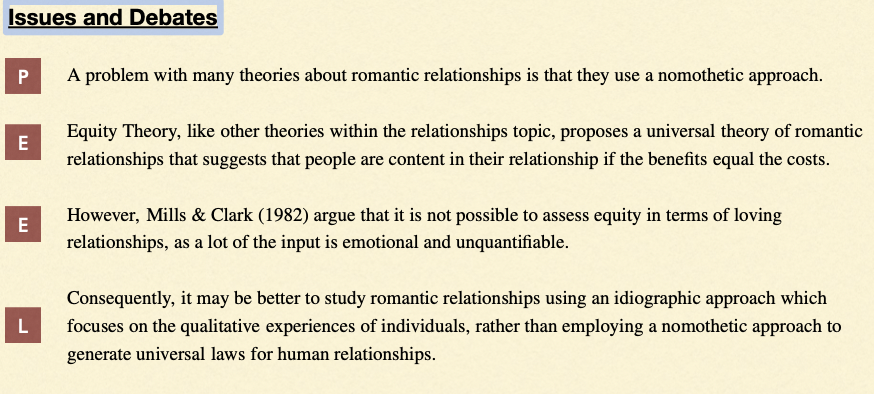6) Equity Theory
1/10
There's no tags or description
Looks like no tags are added yet.
Name | Mastery | Learn | Test | Matching | Spaced |
|---|
No study sessions yet.
11 Terms
Who created the equity theory and when?
Walster 1978
Outline equity theory?
Equity theory is an extension of social exchange theory, including the element of equity previously missing from the theory. It was created by Walster.
Suggests that people are content in their relationship if the benefits are roughly equal to the costs.
Relationships that lack equity are more likely to be associated with dissatisfaction.
According to the Equity Theory, a person who gets more benefits out of relationships than they put in will feel guilt and shame, and those who think they put a lot in but get very little back will be angry and resentful.
The longer this feeling of unfairness (lack of equity) goes on, the more likely a couple is to break up.
Moreover, perception of equity changes over time.
For example, it is perfectly normal for many people to put in more than they receive at the beginning of a relationship, but if it carries on like that for too long, it will lead to dissatisfaction.
A partner’s way of dealing with inequity also changes with time.
What seemed unfair in the beginning may become a norm as relationships progress.
Or the partner who gives more may start working even harder on the relationship until the balance is restored.
Define equity?
Fairness.
Explain inequity according to the theory?
Inequity means that one partner over benefits and the other under benefits.
This causes dissatisfaction for both parties.
Over benefiting party feels shame
Underbenefiting party feels resentment.
Name a researcher who investigates equity?
Walster et al
Describe briefly Walster et al’s findings on equity?
WALSTER ET AL:
Suggests that what matters most is that both partners level of profit is roughly the same.
Inequity leads to dissatisfaction.
Describe the difference between equity vs equality?
Equity is not the same as equality.
Equality = sameness.
Equity= fairness.
The distinction is important if a relationship is going to be successful long term.
It is not about the size or the amount of the rewards and costs, but rather the ratio of the two to each other.
Put a lot in and get a lot out and you will feel satisfied.
Also, keep in mind that an equal distribution may still not be fair (e.g: for people with disabilities).
Satisfying relationships are marked by negotiations to ensure equity.
Describe the consequences of inequity?
Equity theory predicts a strong correlation between the size of the perceived inequity and dissatisfaction.
Inequity is dealt with by a change in one of two ways.
A change in perception about what is normal.
An increase in effort put in by the ‘under benefiter’.
Evaluate one strength of equity theory?
STRENGTH: RESEARCH SUPPORT
UTNE ET AL:
Carried out a survey of 118 recently married couples, measuring equity with two self-report scales.
The couples were between 16-45 years old and had been together for more than two years before marrying.
She found that couples who consider their relationship equitable were more satisfied than those who saw themselves as over or under benefitting.
Such research confirms the central prediction of equity theory- increasing its validity.
Evaluate three limitations of equity theory?
LIMITATION: CONTRADICTORY RESEARCH
BERG AND MCQUINN:
Conducted a longitudinal study on 38 dating couples.
They did not find any increase in equity over time.
However, they discovered that a high level of self-disclosure and perceived equity in the beginning was a strong predictor that a couple would stay in the relationship.
The opposite was also true.
In other words, it seems that perceived fairness is ether present or not present in relationships from the start, and does not develop with time, contrary to the prediction of equity theory.
These findings oppose the central claim of the theory and contradicts the idea that equity increases over time, after the initiation of a romantic relationship.
It also suggests that other factors such as self disclosure may play a more important role in relationships.
LIMITATION: CULTURAL LIMITATIONS
AUMER-RYAN ET AL:
Found that there are cultural differences in the link between equity and satisfaction.
She studied couples from an individualistic culture (US) and a collectivist culture (Jamaica).
Couples from the US considered their relationships to be satisfying when it was considered equitable.
Whereas in Jamaica, partners were considered most satisfied when they were over benefiting.
Aumer-Ryan identified that this was true of both men and women.
According to the theory, the concept of equity is something that is strived for by both parties, and under or over benefiting should cause dissatisfaction.
Therefore, this cultural contradiction suggests that the theory is limited as it only applies within certain cultures.
LIMITATION: INDIVIDUAL DIFFERENCES
HUSEMAN ET AL:
Suggested that some people are less concerned about equity than the ‘norm’.
He describes some partners as ‘benevolents’ who are prepared to contribute more and under benefit.
While ‘entitleds’ believe they deserve to over benefit without guilt or distress.
In both cases, neither of the individual types are concerned about striving for equity in a relationship.
This shows that a desire for equity varies from one individual to another.
Therefore, it cannot be a universal feature of maintaining romantic relationships.
Evaluate equity theory using an issues and debates point?
